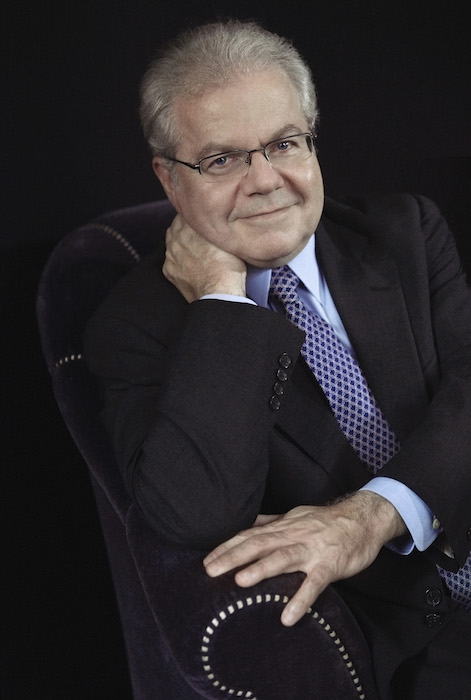Ax sharp in Beethoven, Gabel episodic in Brahms with Houston Symphony

The Houston Symphony and Fabien Gabel skipped the musical appetizer Friday night.
After the house lights of Jones Hall went down, the French guest conductor followed pianist Emanuel Ax onstage and launched the orchestra into Beethoven’s Piano Concerto No. 1–the first of two meaty works that made up the evening’s program.
Gabel gave the concerto a chamber-orchestra tilt, with the string section a handful of members less than full-strength. The sotto voce opening sounded thin at first, largely because the players weren’t quite together. As Gabel got a grip on everyone, the crisp, airy touch took hold.
The orchestra brought out the sleekness of the introduction’s lyrical theme and the vigor of the buildup to the soloist’s entrance. But the music nevertheless had a tinge of squareness: Gabel set a pace that was a little too spacious to give Beethoven a buoyant, confident stride.
The fractional moment of silence that follows the orchestra’s introduction sets up the soloist to make a statement, and Ax did so with bright, clear tone. The piano melody announced that Beethoven’s musical dialogue had a spirited new participant.
Ax brought the music fluency, deftness and ringing sound, all of which helped him animate the music even as he largely stayed with the tempo Gabel had set. Then, in the movement’s midsection–which, at first, contrasts against everything that has gone before it–Ax created a new, ruminative aura, richer in sonority and more expansive in pace.
But it was in the climactic solo cadenza, the biggest and most dramatic of Beethoven’s three options, that Ax really came into his own. For the first time in the performance, Beethoven the young firebrand shone through. Ax swept through flourishes, whipped up rumbling fortissimos, fired off salvos of chords and–at the other extreme–caressed Beethoven’s lyricism.
The slow movement never called for that kind of theatrics, but Ax nevertheless gave it a fervor of its own, spinning out its melodies in long-lined, richly inflected phrases.
Gabel and the accompanying musicians dovetailed with all this, giving the orchestral part clarity and coziness. But at times, Gabel kept a lid on the group, with key solos barely emerging from the orchestral backdrop.
Ax led the way in bringing out the finale’s zip and high spirits. He dug into Beethoven’s bursts of humor, and Gabel spurred the orchestra to add lusty horn calls and general gusto.
Though the first phrases of Ax’s encore–Beethoven’s Für Elise–were nearly lost amid the audience’s sighs of recognition, Ax’s subtlety and muted colors let the famous vignette’s introspection serve as a gentle complement to the concerto’s finale.

After intermission, Gabel and the orchestra turned with Brahms’ Symphony No. 2.
Gabel zeroed in on the shapeliness and glow of the work’s melodies, and the orchestra responded, thanks to the poised strings and literally long-breathed winds.
But the overall flow and blossoming of Brahms’ lyricism weren’t necessarily Gabel’s objective. Instead, he tended to treat each theme and episode as an entity to savor on its own.
In the first movement, Gabel brought out the lilt of the opening theme, the swell of the cellos’ melody and the impact of the agitation that burst out later. As he slowed down the end of a section or lingered over the setup of a new theme, though, the movement broke into a string of separate sections.
In the slow movement, Gabel relished each melody’s rise and fall of intensity–reaching toward the orchestra almost like a sculptor shaping his material. The orchestra delivered broad-lined, rich-toned playing, but the results had no urgency or momentum. The movement came across as a series of manicured melodies rather than music with something to say.
Gabel brought out the contrast between the third movement’s easygoing main tune and its breezy transformations–the latter crackling with energy, thanks to the orchestra’s fleetness and precision. But the way Gabel drew out the final moments contradicted the prevailing lightness.
The orchestra’s agility let it fill the finale with dynamism–as much in quiet spots, such as the beginning, as in the bursts of exuberance that followed. The strings also welled up with especially red-blooded tone in the symphony’s last burst of melody.
But the finale is most powerful when the entire symphony has unfolded as an unbroken stream of expressive lyricism. Gabel didn’t provide the long view, and not for the only time Friday night.
The Houston Symphony repeats the program 8 p.m. Saturday and 2:30 p.m. Sunday in Jones Hall. houstonsymphony.org; 713-224-7575.
Posted Nov 20, 2019 at 5:15 am by John Epstein
Well, one has to read between the lines of Steven Brown’s review to realize this is a pan. And deserves to be! Mr. Gabel waved his arms around a lot, and made not a bit of music out of it all. The accompaniment to the Beethoven 1st Piano Concerto was poor — well, read between the lines again. And the Brahms was pretty terrible overall, despite the efforts of the orchestra, who are paid to follow his lead. I hope Mr. Gabel is NOT being groomed to be the Principal Guest Conductor. His Tchaikovsky Pathetique last season was equally second-rate, tempos all over the place with no direction.
Congratulations on having such a knowledgeable and perceptive critic writing for your site, and kudos to Mr. Brown for knowing how to pan without sounding entirely negative. But this orchestra deserves better — and so do the Houston audience, whether they realize it or not!
Thanks.